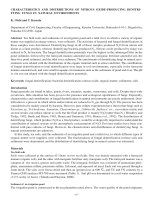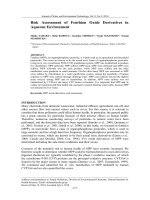Oxide minerals
Bạn đang xem bản rút gọn của tài liệu. Xem và tải ngay bản đầy đủ của tài liệu tại đây (7.71 MB, 30 trang )
The sphere is 6 ft in diameter, the
pilot and 2 observers sit in that
space
1.5-2 hours going down, 1.5-2 hours
coming up bottom time usually
limited by battery consumption…
Wand, nicknamed ‘Fat Albert’ contains 2
electrodes and a thermistor
Voltammetry at 7,500 ft depth
• Riftia field chemistry –
Scans up to 20º C
little/no Fe2+, FeS(aq),
few mM HS-,
• Black Smoker chemistry
– Scans up to 220º C
lots of Fe2+, HS-, FeS(aq),
tens to hundreds of
millimolar Fe and S
Sulfides are reduced minerals
what happens when they contact O2?
•
This is the basis for supergene enrichment and acidic mine drainage
Actively Oxidizing Pyrite
• FeS2 + 3.5 O2 + H2O Fe2+ + 2 SO42- + 2 H+
• FeS2 + 14 Fe3+ + 8 H2O 15 Fe2+ + 2 SO42- + 16 H+
• 14Fe2+ + 3.5 O2 + 14H+ 14 Fe3+ + 7 H2O
• Sulfur species and H+ generation:
– FeS2 + 2 Fe3+ 3 Fe2+ + ¼ S8 + 0 H+
– FeS2 + 7 Fe3+ + 3 H2O 8 Fe2+ + 0.5 S4O62- + 6 H+
AMD neutralization
• Metals are soluble in low pH
solutions – can get 100’s of grams
of metal into a liter of very acidic
solution
• HOWEVER – eventually that
solution will get neutralized
(reaction with other rocks, CO2 in
the atmosphere, etc.) and the metals
are not so soluble but oxidized S
(sulfate, SO42-) is very soluble
• A different kind of mineral is
formed!
Oxides - Oxyhydroxides
• FeOOH minerals Goethite or Limonite (FeOOH)
important alteration products of weathering Fe-bearing
minerals
• Hematite (Fe2O3) primary iron oxide in Banded Iron
Formations
• Boehmite (AlOOH) primary mineral in bauxite ores
(principle Al ore) which forms in tropical soils
• Gibbsite (Al(OH)3) – common Al oxide forming in aqueous
sysems
• Mn oxides form Mn nodules in the oceans (estimated they
cover 10-30% of the deep Pacific floor)
• Many other oxides important in metamorphic rocks…
Al oxides
• Aluminum occurs in economic deposits principally as
bauxite
• Bauxite is a mixture of Al oxides and oxyhydroxides:
– Diaspore - AlO(OH)
– Gibbsite - Al(OH)3
– Böhmite - AlO(OH)
• Al is a residual phase and bauxite occurs where
weathering is extreme and thick layers of aluminum
oxyhydroxide are left over
Mn oxides - oxyhydroxides
• Mn exists as 2+, 3+, and 4+; oxide minerals are varied,
complex, and hard to ID
– ‘Wad’ soft (i.e. blackens your fingers), brown-black
fine-grained Mn oxides
– ‘Psilomelane’ hard (does not blacked fingers) grayblack botroyoidal, massive Mn oxides
• XRD analyses do not easily distinguish different
minerals, must combine with TEM, SEM, IR
spectroscopy, and microprobe work
Mn Oxide minerals (not all…)
• Romanechite
•
•
•
•
•
•
•
•
•
•
•
•
•
•
•
•
•
•
•
Pyrolusite
Ramsdellite
Nsutite
Hollandite
Cryptomelane
Manjiroite
Coronadite
Todorokite
Lithiophorite
Chalcophanite
Birnessite
Vernadite
Manganite
Groutite
Feitknechtite
Hausmannite
Bixbyite
Pyrochroite
Manganosite
Ba.66(Mn4+,Mn3+)5O10*1.34H2O Psilomelane
MnO2
MnO2
Mn(O,OH)2
Bax(Mn4+,Mn3+)8O16
Kx(Mn4+,Mn3+)8O16
Nax(Mn4+,Mn3+)8O16
Pbx(Mn4+,Mn3+)8O16
(Ca,Na,K)X(Mn4+,Mn3+)6O12*3.5H2O
LiAl2(Mn2+Mn3+)O6(OH)6
ZnMn3O7*3H2O
(Na,Ca)Mn7O14*2.8H2O
MnO2*nH2O
MnOOH
MnOOH
MnOOH
Mn2+Mn23+O4
Mn2O3
Mn(OH)2
MnO
Wad
Iron Oxides
•
Interaction of dissolved iron with oxygen yields iron oxide and iron oxyhyroxide
minerals
•
1st thing precipitated amorphous or extremely fine grained (nanocrystaliine) iron
oxides called ferrihydrite
Fe2+
O2
Ferrihydrite
•
Ferrihydrite (Fe5O7OH*H2O; Fe10O15*9H2O some argument about exact formula) –
a mixed valence iron oxide with OH and water
Goethite
•
Ferrihydrite recrystallizes into Goethite (α-FeOOH)
•
There are other polymorphs of iron oxyhydroxides:
– Lepidocrocite γ-FeOOH
– Akaganeite β-FeOOH









